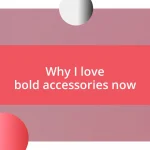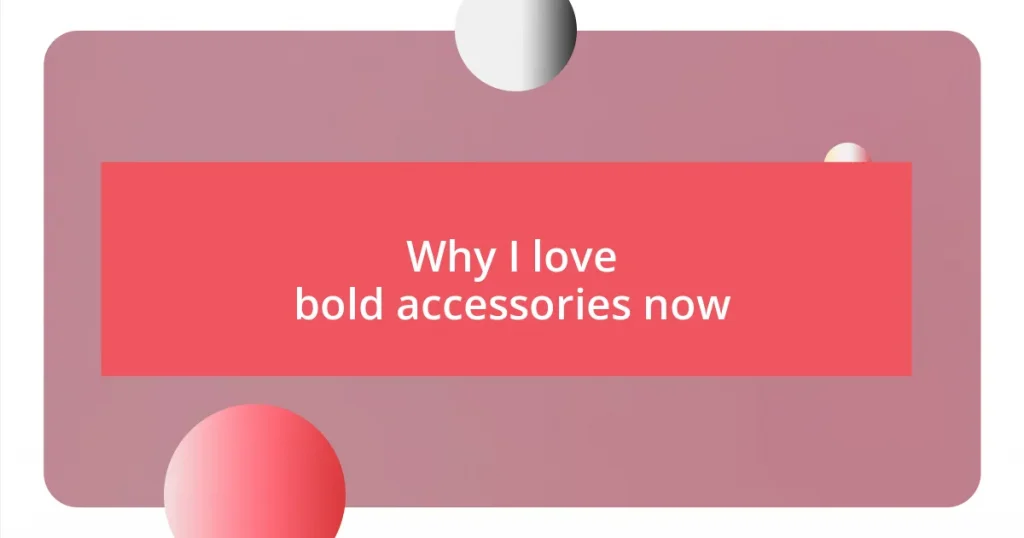Key takeaways:
- Fashion sustainability promotes a circular economy and emphasizes the importance of mindful consumer choices, such as investing in ethically made and quality items.
- Key trends include the rise of eco-friendly materials, clothing rental services, and technological innovations that reduce waste while enhancing shopping experiences.
- Supporting ethical fashion brands fosters transparency in the industry and empowers consumers to make informed decisions that align with their values and contribute to sustainability.
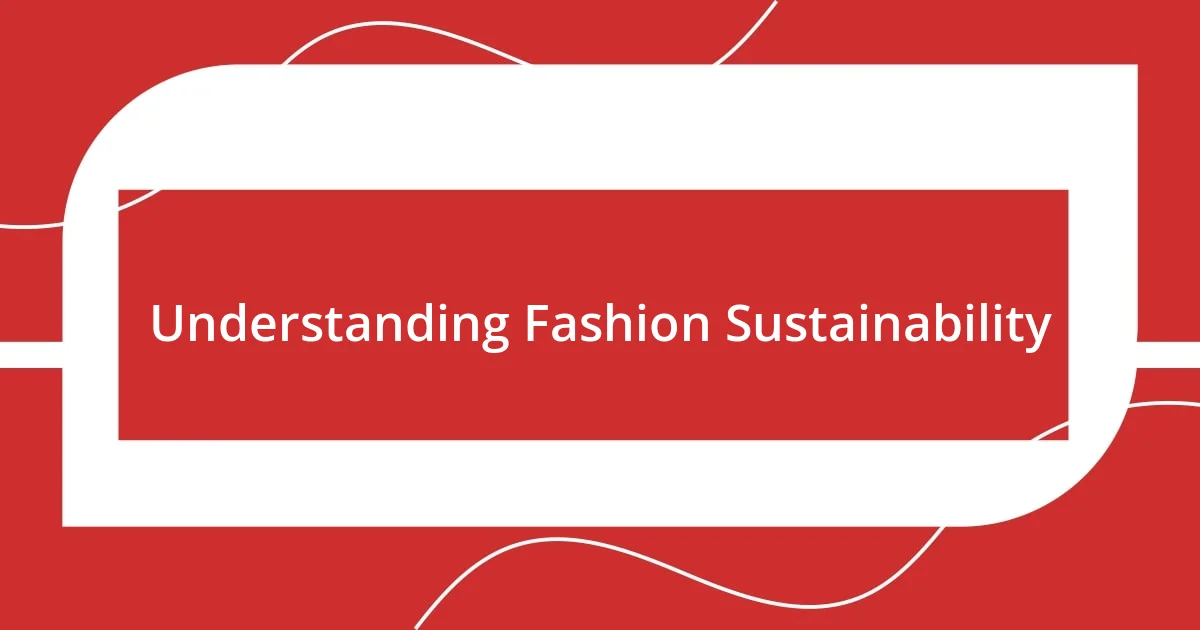
Understanding Fashion Sustainability
Fashion sustainability is all about ensuring that our love for style doesn’t compromise the planet. I still remember a shopping trip where I impulsively bought a trendy shirt, only to realize it was made from cheap materials that would likely end up in a landfill within months. It made me ponder—how many of these items do we buy without thinking about the long-term impact?
What resonates with me most is the concept of a circular economy in fashion, where we shift from the traditional linear model of ‘take, make, dispose’ to a system that promotes reusing and recycling. This shift not only reduces waste but fosters innovation; I’ve had those moments when I see a brand creatively upcycling materials into stunning pieces, and it gets me excited about the potential of sustainable fashion.
I often wonder, how can we, as consumers, play a part in this movement? Every time I choose to invest in pieces that are ethically made or to support second-hand shops, I feel a sense of empowerment. Knowing that my choices contribute to a healthier planet brings meaning to my personal style journey, and I bet many of you feel the same way when you wear cruelty-free or sustainably sourced textiles.
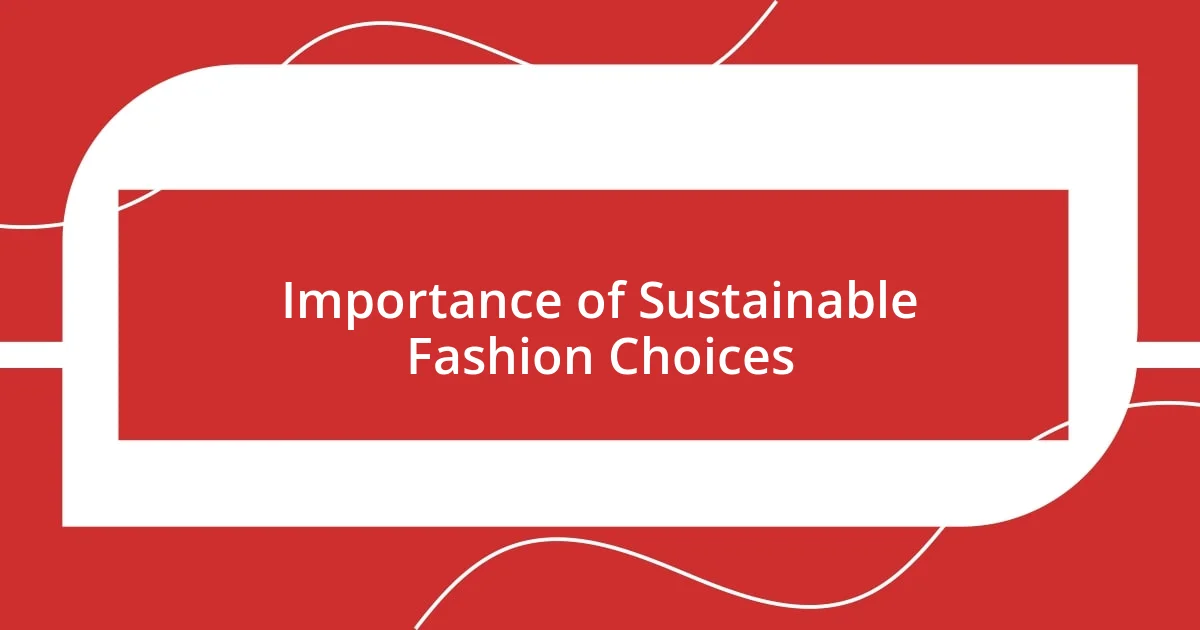
Importance of Sustainable Fashion Choices
Choosing sustainable fashion is more than just a trend; it reflects a commitment to our planet’s well-being. I remember attending a fashion event where a designer passionately spoke about the environmental effects of fast fashion. It struck a chord with me when they revealed that textile production is one of the largest polluters globally. That day, I felt motivated to rethink my shopping habits—not just for my wardrobe, but for the world we live in.
The importance of sustainable fashion choices can be highlighted through these key factors:
- Environmental Impact: Sustainable choices drastically reduce waste and pollution generated by the fashion industry.
- Ethical Practices: Supporting brands that prioritize fair labor ensures workers are treated with dignity and respect.
- Longevity: Investing in quality pieces means they last longer, requiring less frequent replacements and reducing overall consumption.
- Personal Connection: Wearing sustainably made items often gives me a sense of pride, knowing I’m making a positive impact with each choice.
- Influence on Brands: When we choose sustainable fashion, we send a message to companies to prioritize eco-friendly practices.
By embracing sustainable choices, we not only redefine our style but also contribute to a collective movement toward a more conscious world.

Trends in Sustainable Fashion Industry
Some exciting trends are currently shaping the sustainable fashion industry. One that has caught my attention is the rise of eco-friendly materials, such as organic cotton and hemp. I remember visiting a boutique that showcased clothing made from these materials, and I was blown away by how soft and stylish they felt. It’s incredible to see how brands are turning to natural fibers, not only for their sustainability but also for comfort and durability.
Another trend involves the increasing popularity of rental services and clothing swaps. I’ve participated in several swap events where I exchanged clothes with friends, and it felt refreshing to breathe new life into what others might have seen as unwanted. This practice not only promotes sustainability but also encourages community engagement and creativity in how we view our wardrobes.
Lastly, I’m fascinated by technological innovations in sustainable fashion, such as digital fashion shows and virtual fitting rooms. I had a jaw-dropping experience when I tried a virtual fitting app for the first time. It allowed me to see how clothing would fit without even leaving my home. This technology helps reduce returns and thus decreases waste, making it a game-changer in the industry.
| Trend | Description |
|---|---|
| Eco-Friendly Materials | Use of natural fibers like organic cotton and hemp for stylish, durable clothing. |
| Rental Services | Clothing swaps and rental platforms that promote sharing and reduce consumption. |
| Digital Innovations | Adoption of tech like virtual fittings to minimize waste and enhance shopping experiences. |

Practical Tips for Sustainable Wardrobe
Building a sustainable wardrobe starts with evaluating what you already have. I recently took an afternoon to clean out my closet, and it was an eye-opener; I rediscovered beautiful pieces I hadn’t worn in ages. Have you ever considered that your most sustainable choice could just be to shop your own closet? It’s incredible how a fresh perspective can breathe new life into overlooked items.
Another practical tip is to focus on quality over quantity. I recall purchasing a beautifully crafted pair of shoes that cost more than my usual buys. At first, I hesitated, but over time, I learned they were worth every penny; they were not only stylish, but they’ve lasted me years. Investing in fewer, high-quality items not only reduces waste but also assures you’re dressing well without compromising your values.
Lastly, consider adopting a ‘one in, one out’ rule. Whenever I buy something new, I make it a point to let go of an item I no longer wear. This strategy helps keep my wardrobe manageable and reminds me to be more mindful of my shopping habits. It’s a simple yet effective way to maintain balance and ensure each piece in my collection truly serves a purpose. How does your wardrobe reflect your values?
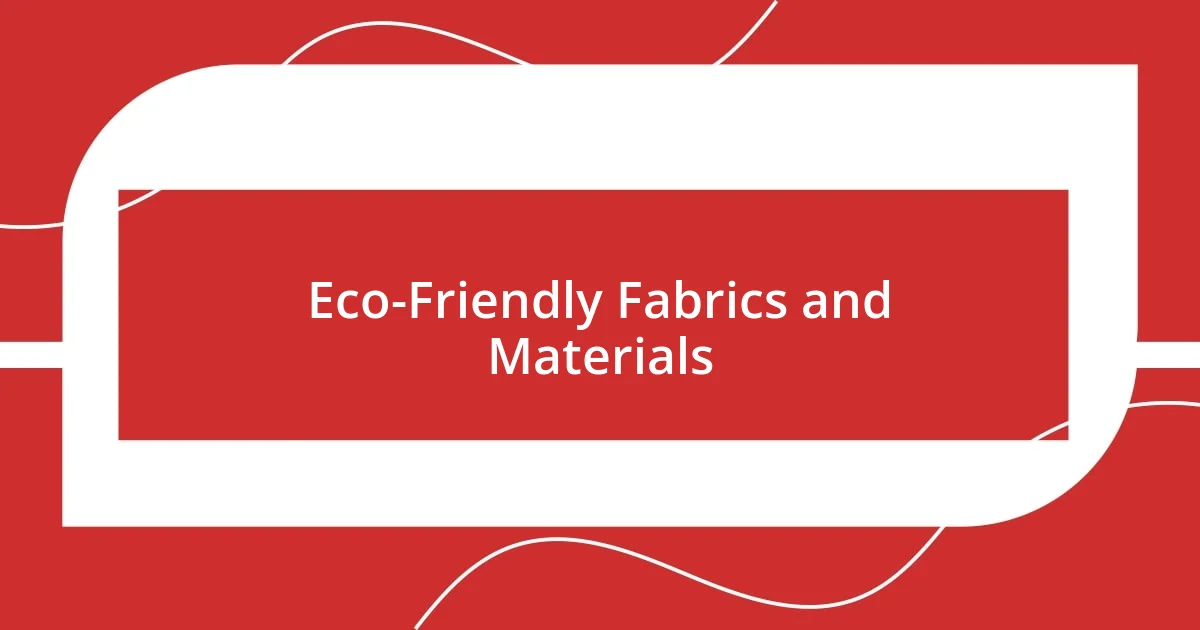
Eco-Friendly Fabrics and Materials
Exploring eco-friendly fabrics has truly opened my eyes to the potential of sustainable fashion. Last summer, I came across a local brand using Tencel, which is derived from wood pulp. I was captivated by its softness and breathability, and learning that the production process is much kinder to the environment just made wearing it feel even better.
I still vividly recall when I first touched linen made from flax fibers. The texture was unlike anything else—lightweight and natural, yet surprisingly strong. Knowing that this fabric requires less water and energy to produce than conventional cotton makes it a no-brainer choice for anyone who loves to blend sustainability with style. Doesn’t it feel great to know you’re making environmentally responsible choices while looking chic?
Hemp, too, is deserving of a mention. I once met a designer at a fair who passionately explained how hemp rejuvenates the soil it grows in. It sparked a conversation about how rediscovering ancient fibers can lead us to a more sustainable future. Have you ever considered how the very fabrics we wear can contribute not just to our comfort but also to the health of our planet?
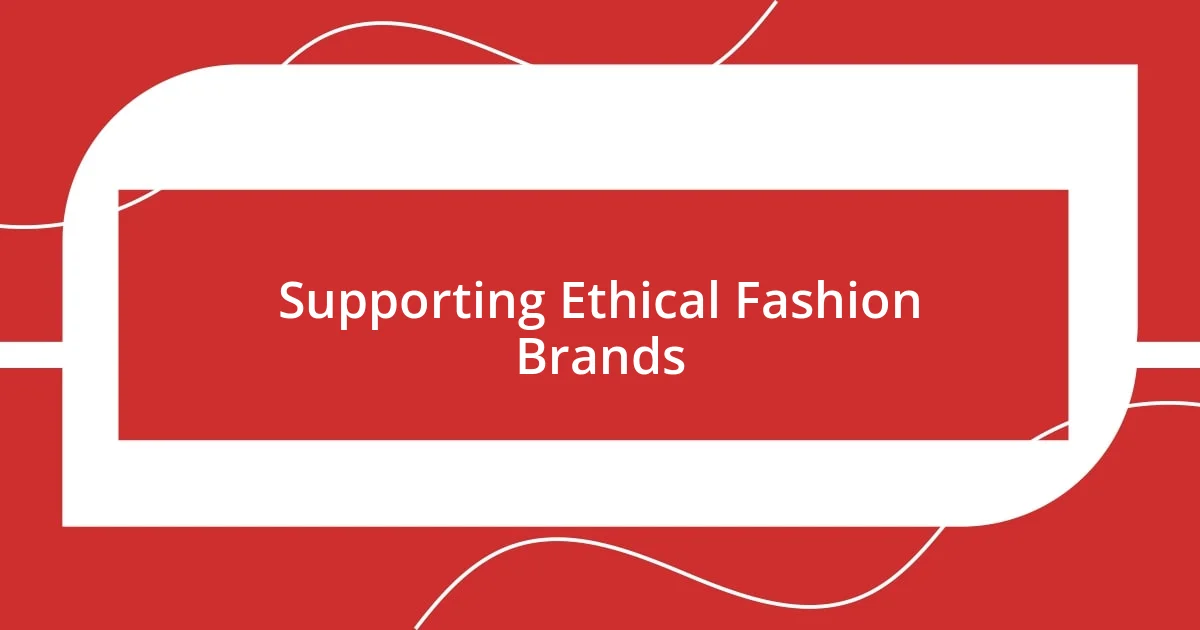
Supporting Ethical Fashion Brands
Supporting ethical fashion brands can be a rewarding journey, both personally and environmentally. When I stumbled upon a small company that ethically sources its materials and pays fair wages to artisans, I felt an immediate connection. Wearing that beautiful dress made from organic cotton was more than just a style choice; it was a conscious decision to support a brand that aligns with my values. Have you found a brand that resonates with you?
I also believe that our choice to support ethical brands extends beyond just clothing. Recently, I attended a pop-up shop featuring local artisans whose dedication and passion for sustainable fashion were evident in every stitch. Engaging with the creators gave me a renewed appreciation for the stories behind the clothes we wear. How often do we consider the journey each piece takes before it reaches our closets?
Moreover, amplifying ethical fashion brands means advocating for a more transparent industry. I remember reading about a brand that shared their entire supply chain online, and it sparked an idea in me about the impact of informed consumer choices. Knowing where my clothes come from isn’t just interesting; it empowers me to make decisions that reflect my commitment to sustainability. What’s stopping you from exploring the ethical fashion landscape?
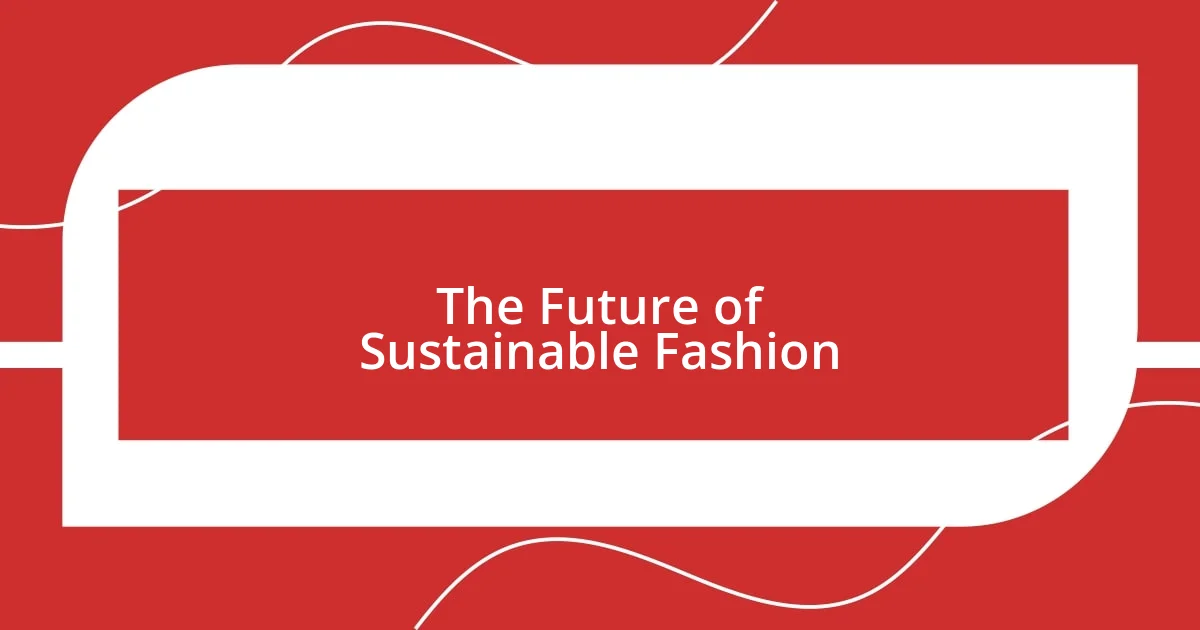
The Future of Sustainable Fashion
The future of sustainable fashion is exciting, as technology and innovation continue to evolve alongside eco-conscious practices. I remember attending a fashion tech conference where they showcased biodegradable dyes that not only reduced pollution but also completely dissolved in water after use. It made me wonder—can our clothing one day leave no trace on the environment? The potential seems limitless!
As more designers embrace circular fashion principles, I’m finding it hard not to get hopeful about what’s coming. I recently tried a clothing rental service that lets me enjoy high-quality outfits without adding to my wardrobe’s footprint. Isn’t it fascinating how this model challenges the traditional notion of ownership? I can wear stunning pieces while contributing to a system that encourages recycling and reuse.
The rise of digital fashion also intrigues me. I was stunned when I saw a virtual fashion show featuring garments designed for avatars instead of physical bodies. It raised a question in my mind: what if the future of fashion doesn’t require us to consume more but allows us to express ourselves in a sustainable way? This blurred line between reality and virtual creation could redefine our shopping habits, making sustainability not just a trend, but a lifestyle.

